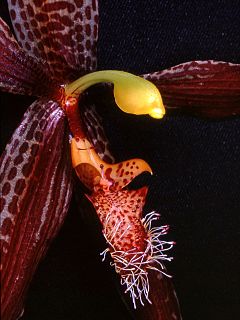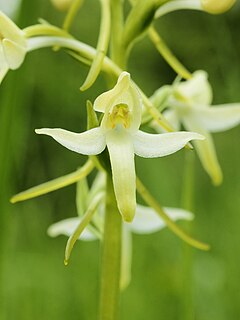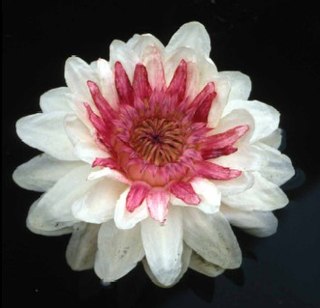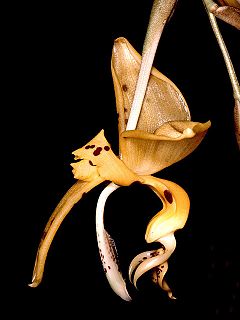
The Orchidaceae are a diverse and widespread family of flowering plants, with blooms that are often colourful and fragrant, commonly known as the orchid family.

Gongora, abbreviated Gga in horticultural trade, is a member of the Orchid family (Orchidaceae). It consists of 65 species known from Central America, Trinidad, and tropical South America, with most species found in Colombia. They grow in wide geographical range from wet forests at sea level to mountainous regions in the Andes, as high as 1,800 m.

Acineta, abbreviated as Acn in horticultural trade, is a small genus belonging to the orchid family (Orchidaceae). The name is derived from the Greek word 'akinetos' (immobile), referring to the rigid labellum (lip).

Dendrophylax lindenii, the ghost orchid is a perennial epiphyte from the orchid family (Orchidaceae). It is native to Florida, Cuba and the Bahamas. Other common names include palm polly and white frog orchid.

Maxillarieae is a large and complex tribe of orchids native to South and Central America. Within the tribe there are eight subtribes one of which is that of the genus Maxillaria.

Maxillaria, abbreviated as Max in the horticultural trade, is a large genus of orchids. This is a diverse genus, with very different morphological forms. Their characteristics can vary widely. They are commonly called spider orchids, flame orchids or tiger orchids. Their scientific name is derived from the Latin word maxilla, meaning jawbone, reflecting on the column and the base of the lip of some species, that may evoke a protruding jaw.

The tribe Euglossini, in the subfamily Apinae, commonly known as orchid bees or Euglossine bees, are the only group of corbiculate bees whose non-parasitic members do not all possess eusocial behavior.

Caladenia, commonly known as spider orchids, is a genus of 350 species of plants in the orchid family, Orchidaceae. Spider orchids are terrestrial herbs with a single hairy leaf and a hairy stem. The labellum is fringed or toothed in most species and there are small projections called calli on the labellum. The flowers have adaptations to attract particular species of insects for pollination. The genus is divided into three groups on the basis of flower shape, broadly, spider orchids, zebra orchids and cowslip orchids, although other common names are often used. Although they occur in other countries, most are Australian and 136 species occur in Western Australia, making it the most species-rich orchid genus in that state.

Stenia is a genus in the orchid family (Orchidaceae). It was established by John Lindley in 1837. These epiphytic plants occur in warm, humid habitats of Trinidad and the Amazonian slope of the northern Andean region in South America.
Houlletia is a genus of large-growing epiphytic orchids native to Mexico, and possibly also Guatemala through Central America to Bolivia. was established with the publication by Brogniartt of Houlletia brocklehurstiana in 1841. The genus is named in honor of orchid collector and grower M. Houllet, French orchid collector in Brazil, later the director of the Botanic Jardin des Plantes in Paris, 19th century

Stanhopeinae is a subtribe of plants in the orchid family.

Paphinia litensis is a species of orchid endemic to Ecuador.

Coeliopsidinae is a subtribe of plants in the orchid family. The three members of this subtribe have traditionally been lumped in with Stanhopeinae, but obvious morphological traits and new molecular analysis by Whitten et al. in 2000 confirmed the group reclassified by Szlachetko (1995).

The genus Platanthera belongs to the subfamily Orchidoideae of the family Orchidaceae, and comprises about 100 species of orchids. The members of this genus, known as the butterfly orchids or fringed orchids, were previously included in the genus Orchis, which is a close relative. They are distributed throughout the temperate regions of the Northern Hemisphere. They are terrestrial and have tubercules.

The Flora of Colombia is characterized by 130,000 species of plants that have been described within Colombian territory.

Embreea is a genus of orchids native to Colombia and Ecuador. The genus Embreea is abbreviated as Emb in horticultural trade. There at present two recognized species:

Catasetinae is a subtribe within the Orchidaceae and contains 8 genera. Its members are widespread in lowland tropical Central and South America up to 1,500 meters. They are found on trees, stumps or old fence posts.

Dendrobium is a genus of mostly epiphytic and lithophytic orchids in the family Orchidaceae. It is a very large genus containing more than 1,800 species that are found in diverse habitats throughout much of south, east and southeast Asia, including China, Japan, India, the Philippines, Indonesia, Australia, New Guinea, Vietnam and many of the islands of the Pacific. Orchids in this genus have roots that creep over the surface of trees or rocks, rarely having their roots in soil. Up to six leaves develop in a tuft at the tip of a shoot and from one to a large number of flowers are arranged along an unbranched flowering stem. Several attempts have been made to separate Dendrobium into smaller genera, but most have not been accepted by the World Checklist of Selected Plant Families.
























